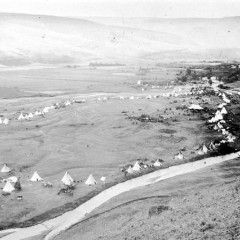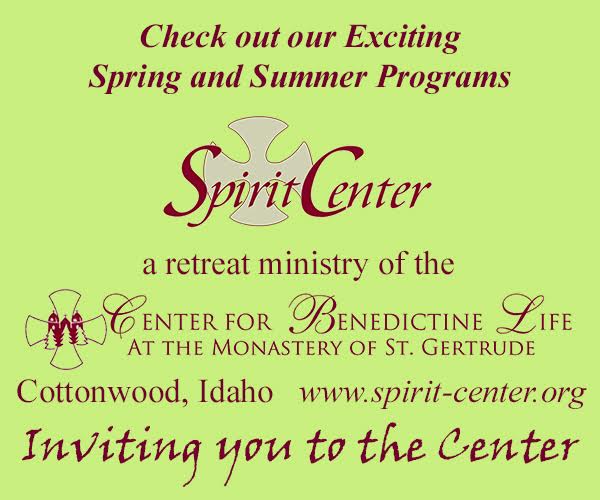“While they were talking and discussing, Jesus himself came near and went with them, but their eyes were kept from recognizing him…” ~Luke 24:15,16

Many moons ago, but not nearly as long ago as the events recorded in Luke’s Gospel, men, women and children gathered along the river valleys of the Snake and the Clearwater in what is now Idaho, Oregon and Washington state… and they discussed Jesus.
They discussed Jesus!
They may not have discussed their hopes for the redemption of Israel, or anything approaching the identity of a particular Palestinian Jew, his disappointing crucifixion or claims of his extraordinary resurrection. But, to the extent they wanted to understand white man’s religion, the Niimiipu sent emissaries to St. Louis, asking for “the book” as well as for teachers who might explain the spiritual secrets of “the book,” and among those secrets, “the things concerning Jesus of Nazareth.”
Enter then, 25 years after their encounters with Lewis & Clark’s Corp of Discovery, Henry H. Spalding. Spalding, via the Oregon Trail, didn’t trade in secrets so much as the stock-answers of the Presbyterian trade. He came with his more amiable spouse, Eliza, and together they dodged mosquitos and began to teach among those curious people who had prompted the discussion in the first place.
The Niimiipu, translated as The “Our People” had earlier been dubbed the Nez Perce (or the Pierced Noses) by various French traders who had lumped them in with their Chinook neighbors further along the Columbia. Those among whom the Spalding’s camped, however, didn’t stick anything in their noses. Their lifestyles revolved around their mouths. Picking berries, foraging for roots, hunting for game and fishing for salmon… they conversed and they ate. The earth exuded abundance, and the sky whispered the possibilities of still more. And yet, might “the book” help? Might “the book” foster an even greater abundance — something more than the food that sustained them?
In acquiescing to the erroneous designation given to them by the French, the Nez Perce had shown their willingness to partner. Partnering involves the terrible risk of being misunderstood, and from their initial encounters with the European explorers, the people of the Columbia Plateau had been profoundly misunderstood. The natives weren’t restless so much as wantonly curious. Moreover, far from being hostile, the Nez Perce learned their hymns and sang every verse. They prayed their prayers the way Henry and Eliza had trained them, verbatim. And many of them were baptized in the Lapwai creek and joined in the Communion feast without even a hint of the doctrinal strife that the Reformation-wreaking Europeans had brought to North America. And all this contrasted, of course, with the way that Marcus and Narcissa Whitman had been treated by the Cayuse, who massacred the adjoining missionaries in 1847.
The Nez Perce, to their own detriment, were nice. Too nice. But what aggrevates me to this day is the church’s complicity in encouraging these niceties. With the signing of treaties, the more Christianized Nez Perce gave away 13 million acres of tribal lands, and when the governor of the Washington Territory invited the younger Chief Joseph to move off his reservation and re-locate elsewhere, he and many others had finally had enough of “the book.” Joseph’s father, the elder Chief Joseph, had actually been baptized by Spalding and received his own Bible. Prior to his son’s rampage in 1877, it had been burned to a crisp of leathery ashes. And here’s my question: What happened?
What in the name of Heaven and Earth (and that’s what we’re missing here) happened?
Today, for the 4,000 Nez Perce, who remain on the 2010 U.S. Census, Presbyterian Christianity still predominates. It’s in the air. It’s in the water. It’s in the pine boughs. Today, although the clans are more disparate and economically desperate, camp meetings can still transport the white visitor back to 19th century missionary cadence. The Nez Perce themselves have never left. And I have to wonder if they’re lingering back there in the 1830’s for the dialogue that Henry Spalding came ill-equipped to deliver.
You see, that’s my thesis, and I know it’s been a long time coming.
I contend that Spalding epitomizes the one-sided missionary monologue that sometimes rears its ugly head in other circles as well. That is, the domineering, condescending, my way or the Lolo Pass highway monologue!
I contend that the proclamation of Christ, if it’s true, ought be put to the test, and that such a test might involve just what exactly we are lifting up as truth. Is it the cognitive and rational faith decision to believe certain things as certain? Or is it the dialogic embodiment of the stories and symbols that Jesus himself left us as ice-breakers? Or is it that relationality sent into other dialogues that have been underway and on-going for centuries upon centuries?
Anyway, here’s where I believe it all went wrong between the Nez Perce and the Presbyterians. It went wrong along the Lapwai creek during the early years of Spalding’s ministry, when a particular shaman had a daughter who married a former fur trapper, named William Craig. William Craig didn’t appreciate the angry and belligerent tone that Spalding often took with the humble people and urged his new father-in-law, Thunder Eyes, to push back. Well, well… this would have been the gruff preacher-man’s big chance. He could have heard the rebuke as a rebuke from God Own Self, and duly chastened, repented there and then. But instead, conjecture has it, Spalding spit nails and cajoled the more passive Nez Perce to conform or suffer the fires of hell.
You might be wondering, at this point, what Thunder Eyes could have offered in a mutual conversation had it occurred (alas, it did not), and my sense is that given the Seven Drum Religion that would develop later among the Nez Perce, the shaman might have talked about Coyote and the Monster, which had been among the mythic metaphors passed on from generation to generation.
Coyote and the Monster is a story that comes from the bowels of creation, and its symbolic richness may have held sway against any of Jesus’ infamous parables, the Lord’s Supper, not to mention the salvific nature of Jesus’ dying and rising again. It goes like this: after all the animals of the world had been eaten by a great monster from the north, Coyote feels lonely and wonders what had happened to all of his friends. He realizes they have been consumed and then devises a secret plan for rescuing them from the gullet of the beast once and for all. Coyote then paints himself the color of the earth and tells the Monster to come and eat him. Coyote, however, had tied himself to the mountain peaks so strongly that he couldn’t be eaten. The Monster then takes a liking to Coyote and they become friends. One day, the Coyote asks the Monster if he might go and see the mice, chipmunks, rattlesnakes, deer, elk and bear. The Monster concedes and Coyote ventures further and further deeper into the innards, where at last, he finds his friends and informs them of their impending rescue. Once the Monster’s heart has been sliced up with a knife, they are to exit an orifice of the Monster and be shaped according to that mouth, eye, nostril, ear or anus. When the Monster dies with a final groan, the Coyote then goes about the business of fashioning from bloody water the various human beings of the earth… including the Nez Perce!
Now, Rev. Spalding, sir… I know this isn’t a part of the Bible. But I wonder if the life, death and resurrection of Jesus doesn’t resemble the trickery of Coyote. And I wonder if we’re not being swallowed even now by an even bigger Monster — the Monster of Commercialism and Commodification? And might we talk to one another and listen to one another’s stories as if we didn’t own them ourselves? As if they’d been given to us to discuss? As if there were more at stake than correct thinking?







I seem to have missed the implied connection between belligerent evangelism and commercialism? Could you clarify?
Thanks Mark! I’ll do a follow-up and explain the connection more explicitly.
I agree with Mark, I need some help with the point of the piece. Your conclusion wasn’t clear enough for me.
The point? Clarity? Allow me to review these two paragraphs (below)… But as far as the explicit connection between belligerent, monolithic evangelism and the commodification of the gospel going on today (ie., the Monster), I’ll get back to you.
I contend that Spalding epitomizes the one-sided missionary monologue that sometimes rears its ugly head in other circles as well. That is, the domineering, condescending, my way or the Lolo Pass highway monologue!
I contend that the proclamation of Christ, if it’s true, ought be put to the test, and that such a test might involve just what exactly we are lifting up as truth. Is it the cognitive and rational faith decision to believe certain things as certain? Or is it the dialogic embodiment of the stories and symbols that Jesus himself left us as ice-breakers? Or is it that relationality sent into other dialogues that have been underway and on-going for centuries upon centuries?
The conversation continues: Is Christianity an infomercial, or a spider web conversation? – http://bit.ly/1kzTLek